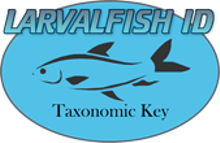 Glossary How to use
Home
Glossary How to use
Home
References
The purpose of these keys is to provide a resource of accepted, assembled data in order to facilitate identification of taxa with the following caveats:
- Many early life descriptions of North America's fishes remain inadequate for species level identification with data more complete at the family level
- More data is available for post yolk-sac larval stages than for egg and yolk-sac.
- More data is available for some families and species than others and thus a targeted species might be eliminated from a search because of that gap
- There may be regional variations between fish of the same or similar species
Thus the key(s) themselves should not be used as a final definitive identification source for regulatory compliance purposes and we recommend that the user go directly to the original referenced sources to confirm fine scale taxonomic identifications.
In addition, it should also be noted that the references provided below are in themselves exhaustive and time-consuming compilations of vast resources that we are unable to acknowledge completely here.
Identification of freshwater fish based on characteristics of egg, yolk sac larvae, and/or larvae primarily in the Great Lakes region including the Colorado River basins, Mississippi River, Ohio River, and Tennessee River. References used to build this key include:
1) Auer, Nancy A. Identification of Larval Fishes of the Great Lakes Basin With Emphasis on the Lake Michigan Drainage. Great Lakes Fishery Commission, 1982.
2) Chapman, D.C and A.E. George. Developmental Rate and Behavior of Early Life Stages of Bighead Carp and Silver Carp, U.S. Geological Survey Scientific Investigations Report, 2011.
3) George, A.E. and D.C. Chapman. Embryonic and Larval Development and Early Behavior in Grass Carp, Ctenopharyngodon idella: Implications for Recruitment in Rivers, PLoS ONE 10(3), March 30, 2015.
4) Hogue, Jacob J., Jr., Robert Wallus, Larry K. Kay. Preliminary Guide to the Identification of Larval Fishes in the Tennessee River, Technical Note B19. Tennessee Valley Authority, Division of Forestry, Fisheries, and Wildlife Development, 1976.
5) Holland-Bartels, L., S. Littlejohn, M. Huston. A Guide to Larval Fishes of the Upper Mississippi River, U.S. Fish and Wildlife Service and Rock Island District of the U.S. Army Corps of Engineers, 1990.
6) Kowalyk, H. Fish Life Histories, [with emphasis on egg stage]
7) Snyder, D. E and S. C. Seal. Computer-interactive Key to Families of Larval Fishes in Freshwaters of the United States and Canada (data set for use with DELTA Intkey). Larval Fish Laboratory, Colorado State University, Fort Collins, 2008 onwards. https://warnercnr.colostate.edu/fwcb/larval-fish-laboratory/downloadable-keys-guides-bibliography/
8) Snyder, Darrel, Sean C. Seal, Jennifer A. Charles, C. Lynn Bjork (illustrator), Cyprinid Fish Larvae and Early Juveniles of the Upper Colorado River Basin: Morphological Descriptions, Comparisons, and Computer-Interactive Key, Larval Fish Laboratory Department of Fish, Wildlife, and Conservation Biology Colorado State University, prepared as a project of Colorado Parks and Wildlife, 2016.
9) Wallus, R., T. P. Simon, and B. L. Yeager. Reproductive biology and early life history of fishes in the Ohio River drainage. [Volume 1: Acipenseridae through Esocidae and Volume 2: Catostomidae]. Tennessee Valley Authority, Chattanooga, Tennessee, USA, 1990.
Identification of fish found along the eastern seaboard of the United States, Atlantic Ocean, based on characteristics of egg, yolk sac larvae, and/or larvae. References used to build this key include:
1) Richards, William J., ed. Early Stages of Atlantic Fishes: An Identification Guide for the Western Central North Atlantic. Boca Raton, FL: CRC Taylor & Francis, 2005.
2) Böhlke, Eugenia B. Fishes of the Western North Atlantic, Part 9 Volume 2: Leptocephali, 1989.
3) Development of Fishes of the Mid-Atlantic Bight: An Atlas of Egg, Larval and Juvenile Stages, U.S. Fish and Wildlife Service Chesapeake Biological Laboratory, 1978.
Identification of fish found along the western coast of the United States, Pacific Ocean, based on characteristics of egg, yolk sac larvae, and/or larvae. Reference used to build this key:
1) Moser, H. Geoffrey, editor. The Early Stages of Fishes in the California Current Region, California Cooperative Oceanic Fisheries Investigations Atlas No. 33 (CALCOFI), Sponsored by the United States Department of Commerce National Oceanic and Atmospheric Administration National Marine Fisheries Service Southwest Fisheries Science Center, Supported in part by a contract with the United States Department of the Interior Minerals Management Service Pacific Outer Continental Shelf Region, 1996.
